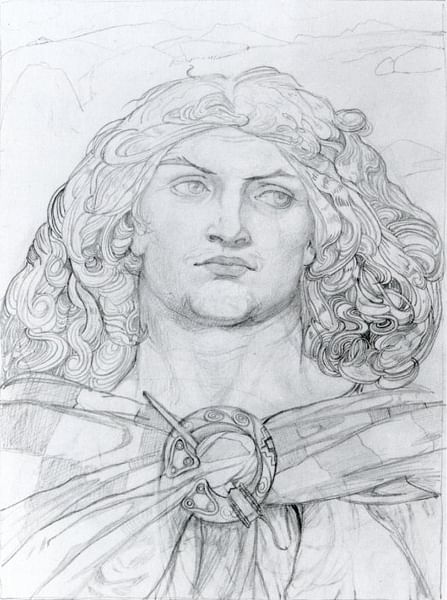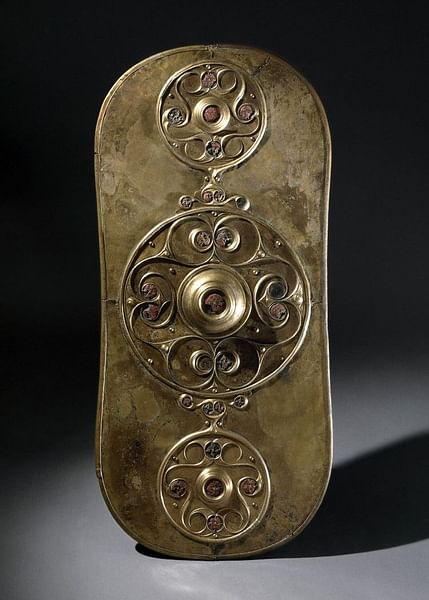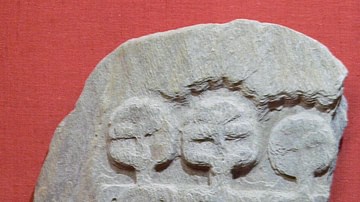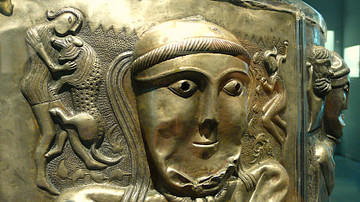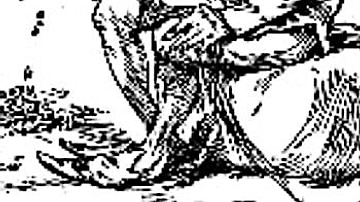
Cú Chulainn (pron. Koo-kul-in), also Cúchulainn, is one of the greatest heroes of Irish-Celtic mythology, particularly the Ulster Cycle. The son of another cultural hero-figure, Lugh, Cú Chulainn is a mighty warrior whose weapon is Gáe Bolga, a terrible spear that inflicts 30 wounds on its target from only a single strike. Cú Chulainn is involved in many adventures such as defending Ulster from a Connacht army, amorous engagements with warrior-queens and fairies, and the tragic killing of his own son Connla. Cú Chulainn is known for his tremendous agility and skills but is ultimately undone by sorcery and killed by another hero, Lugaid mac Con Roi.
Lugh & Birth
Cú Chulainn's father is Lugh the Celtic god of the sun and light who became a heroic figure in Irish epic myths like the Cath Maige Tuired (aka 'The Battle of Mag Tuired'). Lugh led the Tuatha Dé Danann to victory against the Fomorians, a semi-divine race of demonic pirates. Lugh then ruled Ireland for 40 years when the kingdom witnessed only prosperity and bountiful harvests. Cú Chulainn's mother is Deichtine who either swallows a miniaturised version of Lugh while drinking a cup of water or dreams of the god so that she miraculously becomes pregnant with Cú Chulainn. At the mythical capital Emain Macha, Deichtine chooses seven prominent nobles to become the child's foster fathers, amongst them is Sultam mac Róich (often taken as the real father).
Cú Chulainn's name, which comes in a myriad of spelling variations, means 'the hound of Culann' after the great smith of Irish mythology. This story is told in the Macgnímrada Con Culainn ('Cú Chulainn's Boyhood Deeds'). Cú Chulainn, who is first called Sétanta, acquires his more familiar name because he kills, albeit in self-defence, Culann's guard dog, which was so ferocious it had to be kept on three chains and held by nine stout warriors. In repentance for this deed, he offers to replace the hound with another and in the meantime to guard Culann's cattle himself. All of this happened when Sétanta was aged seven and also takes up the first part of the 7-8th century CE epic Táin Bó Cuailnge ('Cattle Raid of Cooley') which tells of a raid on Ulster by an army from Connacht to steal a sacred bull, Donn Cuailnge, and the efforts of Sétanta, now Cú Chulainn, who holds off the invading army single-handedly. The name Sétanta may in some way be connected to the Setantii of ancient Britain, who are mentioned by Roman writers.
Appearance
Cú Chulainn is frequently envisaged as a small, dark, beardless figure with incredible speed, agility, and energy. In many ways, then, he is like the Gaulish Mercury who is similarly equated with Lugh. Indeed, some scholars suggest that Lugh and Cú Chulainn may be one and the same or at least derived from the same inspirational source.
Cú Chulainn certainly has a unique appearance. His hair has three colours: brown, blond, and bright red. Each of his cheeks has four dimples which are blue, red, yellow, and green. He has seven toes on each foot, seven fingers on each hand, and seven pupils in each of his eyes. Despite, or even because of, this peculiar appearance, Cú Chulainn is considered handsome and women are greatly attracted to him. Finally, Cú Chulainn is known to transform himself into a tower of raging fury just before a battle. During this fury, his body is warped with parts shifting about, his crown spurts columns of blood and a great light, the lón láith, shines from his forehead.
Emer
His wife is Emer, younger daughter of Forgall Manach, king of Lusca (Lusk). Forgall Manach wished that his elder daughter be married before Emer and he is not impressed with Cú Chulainn's lack of reputation. To these ends, the king sets our hero a series of difficult tasks. Cú Chulainn eventually returns to Lusca, kills 24 of the king's best men, and elopes with Emer and a quantity of loot. The pair settle in the fortress of Dún Delga (Dundalk), which overlooks the plain of Mag Muirthemne. The marriage has its rocky patches because of Cú Chulainn's many affairs, notably with the fairy Fand (aka Fann), the wife of Manannán mac Lir, the sea god ruler of the Otherworld. Thanks to a magic cloak of forgetfulness, though, all is forgiven and forgotten. In other, less well-known versions, Cú Chulainn's wife is Eithne Ingubai, but it is possible she and Emer are one and the same character.
Scáthach & Ferdiad
Cú Chulainn is trained in weaponry by Scáthach, a female warrior who lived on the Isle of Sky or the Scottish mainland. Cú Chulainn also learns here his ability to make prodigious leaps (and hence today many prominent coastal rocks in Ireland are called 'Cúchulain's Leap'). Scáthach and Cú Chulainn may have been lovers as he is described as gaining 'the friendship of her thighs', although this may refer to some martial ritual whose significance has now been lost.
Scáthach gives Cú Chulainn his terrible barbed spear called Gáe Bulga (aka Bolga) which, when striking an enemy, creates another 30 internal wounds. The spear was made from the bones of a mighty sea monster, and it could travel with lightning speed. His swift and unbreakable sword is Caladbolg, and his two trusty horses are Liath Macha and Saingliu, both are magical beings whom our hero trained personally.
With him in this period is his great friend and sworn brother-in-arms, Ferdiad who is also trained by Scáthach. Cú Chulainn and Ferdiad one day fight each other, actually a might battle that takes three days. Ferdiad had been duped into fighting his great friend by the goddess/warrior-queen Medb, wife of King Ailill mac Mágach of Connacht. Ferdiad was able to resist our hero for so long because he wore impenetrable armour made of horn, but eventually, Cú Chulainn dispatched his friend with his spear. Cú Chulainn's other notable martial adventures include a contest with a giant to see how many victims they could each decapitate and the killing of the one-eyed Goll mac Carbada, another giant.
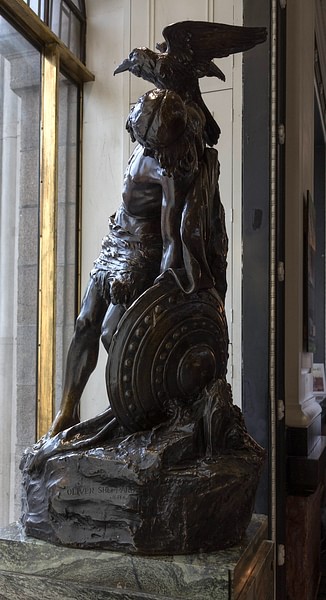
Aife & Connla
Cú Chulainn defeated in battle and then has an affair with Aife, the female chief who was thought to have resided in Scotland (then known as Alba). Aife and Scáthach may be the same individuals or two different aspects of the same character. The pair had a son, Connla, who was unknowingly killed by his father. The story is told in the Aided Óenfhir Aife ('The Tragic Death of Aife's Only Son'). Connla appeared off the coast of Ireland one day rowing a bronze boat with golden oars. Connla defeated two champions in combat and so Cú Chulainn was called upon to fight this stranger who refused to give his name. The fight was a tremendous tussle, but Cú Chulainn finally got the upper hand as they waded into the sea, and he speared the stranger with Gáe Bulga. It was then, as the dying youth revealed that his teacher in weaponry had been Scáthach, the victor realised he had killed his son.
Lugaid mac Con Roi & Death
Lugaid mac Con Roi was a legendary warrior who hated Cú Chulainn because the latter had had an adulterous affair with his mother, Bláithíne when on a raid in Scotland. Even worse, Cú Chulainn killed Con Roi, the father of Lugaid mac Con Roi. The pair meet in battle, and Cú Chulainn's charioteer Loegh (aka Láeg) is killed by the spear of Lugaid mac Con Roi which was aimed at Cú Chulainn. Another spear is launched and hits Cú Chulainn in the abdomen but he does not die. Lugaid mac Con Roi then decapitates Cú Chulainn. The hero's death after such a long run of successes in battles is sometimes explained as divine retribution for having broken a taboo or geis, in this case, Cú Chulainn ate the meat of a dog.
In another version of our hero's demise (and there are many), he fights and is the last man standing in a battle with followers of Medb. Cú Chulainn even chains himself to a column so that he can fight on with his many wounds. Eventually, a raven comes and plucks out his eyes and he dies. The column is said to be still standing and visible at Knockbridge in County Louth. Cú Chulainn may have died young but at least he got his wish for he had once said "Provided I am famous, I do not care whether I live but a single day in this world" (Eleure, 143).
